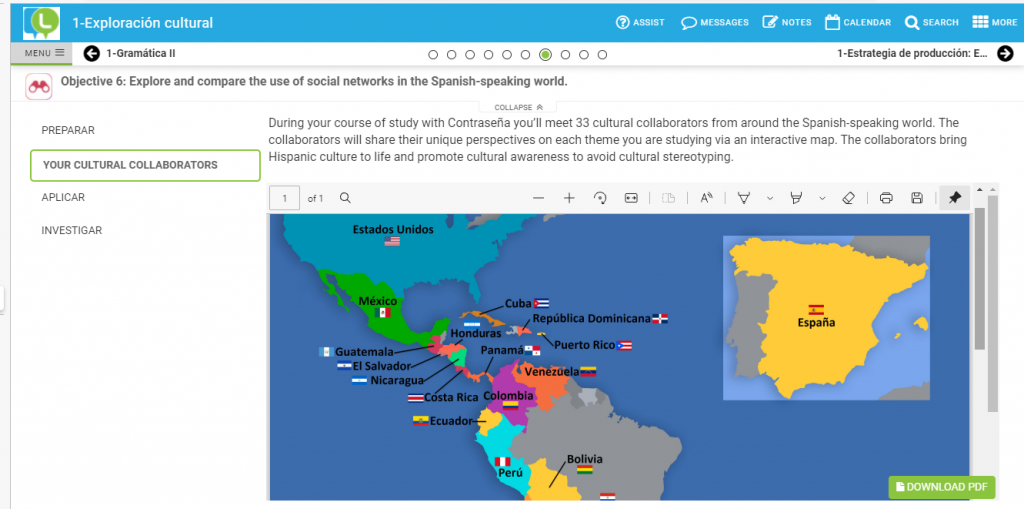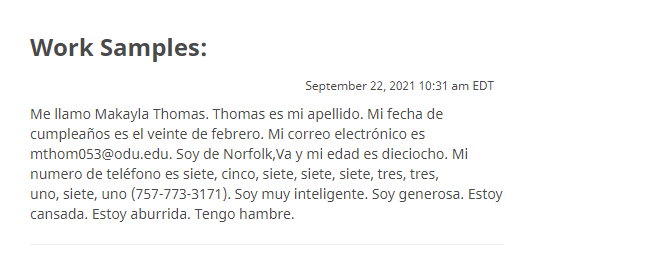Exploring Culture
During this Spanish 101 course, I’ve learned how to communicate with and understand Spanish speakers. The course consisted of speaking, writing, and listening assignments that helped me develop better Spanish speaking skills.
Practicing and studying Spanish outside of school hours helped my pronunciation and knowledge of the words. The book provided helped me with verbs, nouns, conjugations, etc. The difference between English and Spanish is drastic and took a while for me to become accustomed to. The projects and assignments assigned from the textbook allowed me to understand Hispanic culture by showing videos of different Spanish speakers worldwide and educating me about their culture.

Engaging in Communities
Growing up, I was always surrounded by Dominican, Puerto Rican, and Cuban Culture. I engage in communities by going to local restaurants like La Yaroa, a Dominican and Puerto Rican Restaurant located in Norfolk, Virginia, hanging out with my Spanish native friends, and listening to Hispanic music.
Going to local restaurants allowed me to feel confident while speaking Spanish and also allowed me to taste unique dishes. While listening to Hispanic music such as Reggaeton, Dembow, and Bachata helped me better understand the language and culture.


Interpersonal Communication
Most of the assignments I had to complete were through the textbook. Conversations, Grammar, Introductions, Vocabularies, Quizzes, and Projects were all assignments provided by the textbook that helped me enhance my Spanish.
In my Spanish 101 class, all of the students are always participating and interacting with each other. For the Conversation section of the textbook, we are required to work with a partner. We can speak with other students who are learning the language and point out any mistakes each student may make. We had to listen, chat, and write for most assignments, which allowed me to practice my pronunciation, spelling, and listening skills. I had difficulty conjugating certain words in Spanish, but by practicing outside of school hours and studying, I overcame this struggle. Reading and writing Spanish also helped me enhance my skills.

Presentational Speaking
Throughout the course, I’ve completed multiple conversational assignments with my classmates and instructor. Outside of school, I’ve communicated with Spanish-speaking friends and family.
The second project we had to complete for the class required interviewing a classmate or an actual Spanish speaker. We asked questions regarding the person’s personality and the university, like how you are, your name, where you are from, your major, what classes you are studying, etc. While recording the video for this assignment, I noticed I struggled with sounding natural during the conversation. I was a bit hesitant with my responses. With my instructor, we’ve practiced personality questions. Having these different conversations helped me evolve as a Spanish speaker. Most of the time, we are reading instead of speaking, and having these speaking assignments allowed me to express confidence while speaking Spanish.
Presentational Writing
A writing assignment was assigned as our first project. We had to introduce ourselves, say where we were from, and give our contact information.
By studying the vocabulary in the textbook, I was able to learn the meaning and spelling for each word. It was hard for me to remember where to put accent marks for each term for my first writing assignment. Over time, I became better at putting accent marks in the correct places. Instead of having such short responses, I learned how to be more descriptive when writing in Spanish.

Interpretive Listening
I’ve completed a few assignments where I listened to the audio and wrote what I’ve heard. I’ve watched a few videos of Spanish speakers speaking as well.
By listening to each audio more than once, I was able to improve my listening skills. I’ve never had difficulties understanding a Spanish speaker, but I do have problems understanding a few words. In Spanish, natives from all over have different dialects, so it was a bit hard to understand some of the videos we watched during class. By listening to multiple genres of Spanish-speaking music, I was able to understand particular dialects better. lIstening to Hispanic music helped me improve my listening skills and gave me a better understanding of the language.

Interpretive Reading
We are provided a Preparation tab that requires us to read before completing the assignments for each assignment. We also have the opportunity to read aloud sometimes.
I’ve volunteered a few times to read aloud in front of the class. The first time I tried translating a paragraph, I didn’t understand a few words I read. For the Preparation section of the textbook, there are texts with lots of descriptions and Spanish words I have not memorized. Using my time to read each word carefully and think about what I was reading allowed me to overcome these difficulties. My comprehension has increased and continues to increase the more I read.
